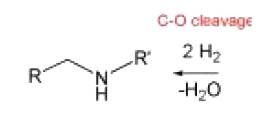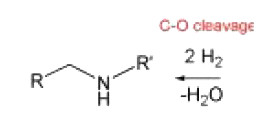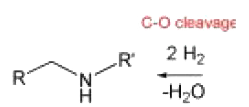Assertion: Phosphorus cycle is an imperfect cycle as a sufficient amount of phosphorus combines with Al3+Fe2+ and Ca2+ to form insoluble and unavailable salts.
Reason: Phosphate circulation in abiotic environment in lithosphere as well as in atmosphere.
The correct Answer is:C
Phosphorus cycle is an example of sedimentary cycle. Greatest reservoir of phosphate in the world is relatively insoluble ferric and calcium phosphate in rocks. Cyclic pool is soil for terrestrial ecosystems (lithosphere) and water for aquatic ecosystems (hydrosphere). Phosphate circulates in the abiotic environment in lithosphere as well as hydrosphere. Atmosphere or gaseous cycle is absent. Inside soil some phosphorus is lost through leaching. Similarly, a sufficient amount of phosphorus combines with calcium, iron or aluminium and becomes insoluble. It settles and teeth may also remain undergraded. Such phosphorus becomes part of lithosphere. It is released after a very long weathering agencies or are mined. Thus, phosphorus cycle is an imperfect cycle.
Topper's Solved these Questions
Similar Questions
Read the given passage and answer the questions that follow :
Molecular nitrogen comprises 78% by volume of the atmosphere. In the earth's crust, it occurs as sodium nitrate, NaNO3 (called Chile saltpetre) and potassium nitrate (Indian saltpetre). It is found in the form of proteins in plants and animals. Phosphorus occurs in minerals of the apatite family, Ca9(PO4)6.CaX2(X=F,ClorOH)(for example, fluorapatite Ca9(PO4)6.CaF2) which are the main components of phosphate rocks. Phosphorus is an essential constituent of animal and plant matter. It is present in bones as well as in living cells. Phosphoproteins are present in milk and eggs. Arsenic, antimony and bismuth are found mainly as sulphide minerals. Moscovium is a synthetic radioactive element. Its symbol is Mc, atomic number 115, atomic mass 289 and electronic configuration [Rn]5f156d107s27p3.
Name the natural substances that contain phosphorus.View SolutionRead the given passage and answer the questions that follow :
Molecular nitrogen comprises 78% by volume of the atmosphere. In the earth's crust, it occurs as sodium nitrate, NaNO3 (called Chile saltpetre) and potassium nitrate (Indian saltpetre). It is found in the form of proteins in plants and animals. Phosphorus occurs in minerals of the apatite family, Ca9(PO4)6.CaX2(X=F,ClorOH)(for example, fluorapatite Ca9(PO4)6.CaF2) which are the main components of phosphate rocks. Phosphorus is an essential constituent of animal and plant matter. It is present in bones as well as in living cells. Phosphoproteins are present in milk and eggs. Arsenic, antimony and bismuth are found mainly as sulphide minerals. Moscovium is a synthetic radioactive element. Its symbol is Mc, atomic number 115, atomic mass 289 and electronic configuration [Rn]5f156d107s27p3.
Give the electronic configuration of Moscovium.View Solution
Knowledge Check
- Question 1 - Select One
Assertion. Deamination takes place in the hepatocytes by oxidase by oxidase enzyme, producing NH3.
Reason. Ornithine cycle combines NH3 and CO2 to form urea in the adipocytes.AIf both A and R are true and R is the correct explanation of A.BIf both A and R are true but R is not the correct explanation of A.CIf A is true but R is false.DIf both A and R are false. - Question 2 - Select One
Read the passage given below and answer the following questions:
Within the 3d series, manganese exhibits oxidation states in aqueous solution from +2 to +7, ranging from Mn2+(aq) to MnO−4 (aq). Likewise, iron forms both Fe2+(aq) and Fe3+(aq) as well as the FeO2−4 ion. Cr and Mn form oxyions CrO2−4,MnO−4, owing to their willingness to form multiple bonds . The pattern with the early transition metals-in the 3d series up to Mn, and for the 4d, 5d metals up to Ru and Os—is that the maximum oxidation state corresponds to the number of ‘‘outer shell’’ electrons. The highest oxidation states of the 3d metals may depend upon complex formation (e.g., the stabilization of Co3+ by ammonia) or upon the pH (thus MnO2−4 (aq) is prone to disproportionation in acidic solution). Within the 3d series, there is considerable variation in relative stability of oxidation states, sometimes on moving from one metal to a neighbor, thus, for iron, Fe3+ is more stable than Fe2+, especially in alkaline conditions, while the reverse is true for cobalt. The ability of transition metals to exhibit a wide range of oxidation states is marked with metals such as vanadium, where the standard potentials can be rather small, making a switch between states relatively easy.
(Cotton, S. A. (2011). Lanthanides: Comparison to 3d metals. Encyclopedia of inorganic and Bioinorganic Chemistry.)
In the following questions, a statement of assertion followed by a statement of reason is given. Choose the correct answer out of the following choices on the basis of the above passage.
Assertion: Highest oxidation state is exhibited by transition metal lying in the middle of the series.
Reason: The highest oxidation state exhibited corresponds to number of (n-1)d electrons.AAssertion and reason both are correct statements and reason is correct explanation for assertion.BAssertion and reason both are correct statements but reason is not correct explanation for assertion.CAssertion is correct statement but reason is wrong statement.DAssertion is wrong statement but reason is correct statement. - Question 3 - Select One
Read the passage given below and answer the following questions:
Reduction of carboxylic acids and their derivatives plays an important role in organic synthesis, in both laboratory and industrial processes. Traditionally, the reduction is performed using stochiometric amounts of hydride reagents, generating stochiometric amounts of waste. A much more attractive, atom-economical approach is a catalytic reaction using H2, however, hydrogenation of carboxylic acid derivatives under mild conditions is a very challenging task, with amides presenting the highest challenge among all classes of carbonyl compounds. Very few examples of the important hydrogenation of amides to amines, in which the C-O bond is cleaved with the liberation of water (Scheme 1), were reported. C-O cleavage of amides can also be affected with silanes as reducing agents.

We have now prepared the new, dearomatized, bipyridine-based pincer complex 3, catalyst 3(Here refered as Cat. 3). Remarkably, it efficiently catalyzes the selective hydrogenation of amides to form amines and alcohols (eq 1). The reaction proceeds under mild pressure and neutral conditions, with no additives being required. Since the reaction proceeds well under anhydrous conditions, hydrolytic cleavage of the amide is not involved in this process.

(Balaraman, E., Gnanaprakasam, B., Shimon, L. J., & Milstein, D. (2010). Direct hydrogenation of amides to alcohols and amines under mild conditions. Journal of the American Chemical Society, 132(47), 16756-16758.)
In the following questions, a statement of assertion followed by a statement of reason is given. Choose the correct answer out of the following choices on the basis of the above passage.
Assertion: Aniline can be prepared from suitable amide using catalyst 3
Reason: The use of catalyst 3 is limited to aliphatic amides only.AAssertion and reason both are correct statements and reason is correct explanation for assertion.BAssertion and reason both are correct statements but reason is not correct explanation for assertion.CAssertion is correct statement but reason is wrong statement.DAssertion is wrong statement but reason is correct statement.
Read the passage given below and answer the following questions:
Reduction of carboxylic acids and their derivatives plays an important role in organic synthesis, in both laboratory and industrial processes. Traditionally, the reduction is performed using stochiometric amounts of hydride reagents, generating stochiometric amounts of waste. A much more attractive, atom-economical approach is a catalytic reaction using H2, however, hydrogenation of carboxylic acid derivatives under mild conditions is a very challenging task, with amides presenting the highest challenge among all classes of carbonyl compounds. Very few examples of the important hydrogenation of amides to amines, in which the C-O bond is cleaved with the liberation of water (Scheme 1), were reported. C-O cleavage of amides can also be affected with silanes as reducing agents.

We have now prepared the new, dearomatized, bipyridine-based pincer complex 3, catalyst 3(Here refered as Cat. 3). Remarkably, it efficiently catalyzes the selective hydrogenation of amides to form amines and alcohols (eq 1). The reaction proceeds under mild pressure and neutral conditions, with no additives being required. Since the reaction proceeds well under anhydrous conditions, hydrolytic cleavage of the amide is not involved in this process.

(Balaraman, E., Gnanaprakasam, B., Shimon, L. J., & Milstein, D. (2010). Direct hydrogenation of amides to alcohols and amines under mild conditions. Journal of the American Chemical Society, 132(47), 16756-16758.)
In the following questions, a statement of assertion followed by a statement of reason is given. Choose the correct answer out of the following choices on the basis of the above passage.
Assertion: N-methyl ethanamide on reaction with catalyst 3 will yield ethanol and methanamine.
Reason: Use of Catalyst 3 brings about cleavage of C-N bond of amidesView SolutionRead the passage given below and answer the following questions:
Reduction of carboxylic acids and their derivatives plays an important role in organic synthesis, in both laboratory and industrial processes. Traditionally, the reduction is performed using stochiometric amounts of hydride reagents, generating stochiometric amounts of waste. A much more attractive, atom-economical approach is a catalytic reaction using H2, however, hydrogenation of carboxylic acid derivatives under mild conditions is a very challenging task, with amides presenting the highest challenge among all classes of carbonyl compounds. Very few examples of the important hydrogenation of amides to amines, in which the C-O bond is cleaved with the liberation of water (Scheme 1), were reported. C-O cleavage of amides can also be affected with silanes as reducing agents.

We have now prepared the new, dearomatized, bipyridine-based pincer complex 3, catalyst 3(Here refered as Cat. 3). Remarkably, it efficiently catalyzes the selective hydrogenation of amides to form amines and alcohols (eq 1). The reaction proceeds under mild pressure and neutral conditions, with no additives being required. Since the reaction proceeds well under anhydrous conditions, hydrolytic cleavage of the amide is not involved in this process.

(Balaraman, E., Gnanaprakasam, B., Shimon, L. J., & Milstein, D. (2010). Direct hydrogenation of amides to alcohols and amines under mild conditions. Journal of the American Chemical Society, 132(47), 16756-16758.)
In the following questions, a statement of assertion followed by a statement of reason is given. Choose the correct answer out of the following choices on the basis of the above passage.
Assertion: The use of catalyst 3 is an efficient method of preparation of primary amines
Reason: Use of catalyst 3 is a step down reaction.View SolutionRead the passage given below and answer the following questions:
Reduction of carboxylic acids and their derivatives plays an important role in organic synthesis, in both laboratory and industrial processes. Traditionally, the reduction is performed using stochiometric amounts of hydride reagents, generating stochiometric amounts of waste. A much more attractive, atom-economical approach is a catalytic reaction using H2, however, hydrogenation of carboxylic acid derivatives under mild conditions is a very challenging task, with amides presenting the highest challenge among all classes of carbonyl compounds. Very few examples of the important hydrogenation of amides to amines, in which the C-O bond is cleaved with the liberation of water (Scheme 1), were reported. C-O cleavage of amides can also be affected with silanes as reducing agents.

We have now prepared the new, dearomatized, bipyridine-based pincer complex 3, catalyst 3(Here refered as Cat. 3). Remarkably, it efficiently catalyzes the selective hydrogenation of amides to form amines and alcohols (eq 1). The reaction proceeds under mild pressure and neutral conditions, with no additives being required. Since the reaction proceeds well under anhydrous conditions, hydrolytic cleavage of the amide is not involved in this process.

(Balaraman, E., Gnanaprakasam, B., Shimon, L. J., & Milstein, D. (2010). Direct hydrogenation of amides to alcohols and amines under mild conditions. Journal of the American Chemical Society, 132(47), 16756-16758.)
In the following questions, a statement of assertion followed by a statement of reason is given. Choose the correct answer out of the following choices on the basis of the above passage.
Assertion: Use of hydride catalyst or hydrogen brings about cleavage of C-O bond in amides.
Reason: Hydride catalyst or hydrogen cause to reduction of amides.View SolutionAssertion : C4plants form food more rapidly more efficiently in photosynthesis than C3 plants.
Reasons : C4plants have a shorter CO2 fixation cycle.View SolutionAssertion. The total content of iron in an adult body is 3.5 gram. The iron deficiency lead to anaemis.
Reason. Iron (Fe2+) combines with the pigment porphyrin to form heme.View Solution

